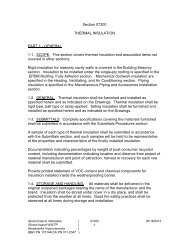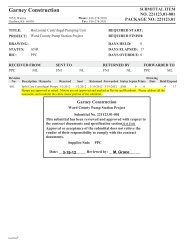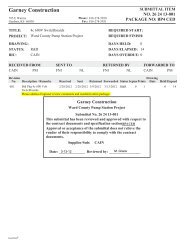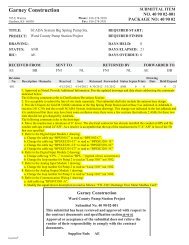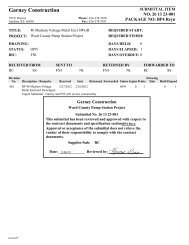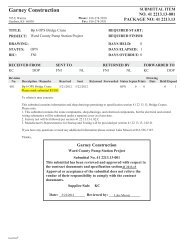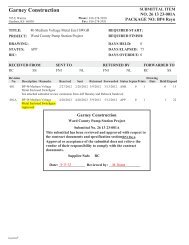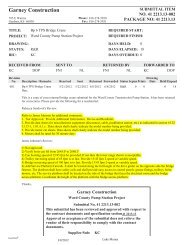33 12 16.26 - 001-A - Butterfly Valves - Garney Construction
33 12 16.26 - 001-A - Butterfly Valves - Garney Construction
33 12 16.26 - 001-A - Butterfly Valves - Garney Construction
You also want an ePaper? Increase the reach of your titles
YUMPU automatically turns print PDFs into web optimized ePapers that Google loves.
Control specification<br />
Local Control<br />
Non-intrusive selectors are provided<br />
on the actuator electrical control cover,<br />
one for Local/Stop/Remote selection,<br />
pad-lockable in each position, and the<br />
other Open/Close control. Local<br />
control may be configured for<br />
maintained or inching operation.<br />
Controls may be rotated to suit<br />
actuator orientation.<br />
Local control may be selected to<br />
operate using the supplied IQ Setting<br />
Tool. The Setting Tool incorporates<br />
dedicated Open, Stop and Close<br />
buttons and will operate over a<br />
nominal distance of 0.75 metres from<br />
the display window.<br />
Vandal Resistant Local Control<br />
Option<br />
Control selectors removed, indication<br />
window with or without removable<br />
cover, control of Local, Stop and<br />
Remote selection and local Open<br />
and Closed control is via the IQ<br />
Setting Tool.<br />
Remote Control<br />
There are six control inputs for remote<br />
control:<br />
● Open, closed, stop/maintain<br />
● Emergency shut down (ESD)<br />
● Open interlock and closed interlock<br />
Control can be connected for<br />
maintained or push to run, “inching”<br />
control. Refer to pages 15-18 for<br />
remote control circuit schematics.<br />
Remote control inputs are optoisolated<br />
interfaces with a surge<br />
immunity of 2kV. Standard control is<br />
positive switching (negative switching<br />
is available if specified).<br />
The standard IQ actuator can be<br />
controlled using remote control signals<br />
defined as follows:<br />
Customer fed control circuit supply:<br />
Within the ranges, 20-60V AC/DC<br />
or 60-<strong>12</strong>0V AC.<br />
Actuator fed control circuit supply:<br />
24V DC. (<strong>12</strong>0V AC available if<br />
specified).<br />
The current drawn for each control<br />
input:<br />
5mA at 24V DC, <strong>12</strong>mA at <strong>12</strong>0V AC<br />
Minimum “ON” voltage: 20V,<br />
Maximum “OFF”: 3V.<br />
Minimum signal duration: 300ms.<br />
Maximum remote control cable<br />
capacitance: 2µF core to core.<br />
IQD - DC actuator remote control<br />
Remote control is available within the<br />
ranges 20-<strong>12</strong>0V AC, 20 - 60V DC, only.<br />
Note: for IQD at 110V DC power<br />
supply, the maximum remote control<br />
input voltage is 60V DC.<br />
For applications where the actuator is<br />
powered from a power supply of<br />
limited capacity such as solar power<br />
charged, direct current UPS system,<br />
power conservation is of prime<br />
importance. The IQD includes a “solar”<br />
feature* to minimise power<br />
consumption when not operating,<br />
reducing the current drawn by the<br />
actuator control to 10mA (maximum).<br />
Applying a remote “open”, “close” or<br />
“ESD” control signal or a discreet<br />
“wake up” signal causes the actuator<br />
to power up its control circuits and<br />
after a delay of up to 1 second,<br />
respond to the remote control signal.<br />
Between 3 and 6 seconds after the<br />
control signal is removed, the actuator<br />
returns to the low current “solar” state.<br />
As part of this routine, in order to<br />
save power, the actuator fed 24V DC<br />
remote control supply is disabled when<br />
in solar mode (note that actuator 24V<br />
DC fed remote control supply is<br />
unavailable for applying a signal to<br />
power up the actuator control when<br />
operation is required and therefore a<br />
discreet externally fed “wake up”<br />
signal or externally powered control<br />
signals must be used).<br />
Two modes of control are available:<br />
● Standard - sleep function disabled,<br />
24V DC remote control supply<br />
available at all times<br />
● “Solar” sleep function enabled, 24V<br />
DC remote control supply disabled<br />
when asleep<br />
Unless otherwise specified, the<br />
actuator will be dispatched configured<br />
in the “solar” mode of control.<br />
Remote control signals must therefore<br />
be a minimum of 1.5 second duration.<br />
The 2 wire remote control form is not<br />
available (refer to page 17). For<br />
Fieldbus system control please apply<br />
to Rotork.<br />
In local control and when “awake”,<br />
the actuator will draw approximately<br />
100mA ( with 24V DC Power Supply)<br />
from the supply in the quiescent state.<br />
Remote control option<br />
For customer fed remote control in the<br />
range 60-<strong>12</strong>5V DC and 230V AC an<br />
alternative control circuit is available<br />
(note: IQD is limited to 20-60V DC and<br />
20 - <strong>12</strong>0V AC only). Remote control<br />
voltages between 150V and 300V AC<br />
must be derived from a designated<br />
Installation Category II supply as<br />
defined in BSEN/IEC61010.<br />
Emergency Shut Down –<br />
ESD<br />
An active ESD signal will override any<br />
local or remote control signal. The<br />
ESD input operates from a separate<br />
common to that used for open, close,<br />
and stop remote control signals. Refer<br />
to page 15 for ESD circuit options.<br />
The following ESD options can be<br />
configured:<br />
● ESD Signal<br />
Active high (contact making)<br />
Active low (contact breaking)<br />
● ESD Action<br />
Close, open, stayput<br />
● ESD Override<br />
Motor thermostat**, local stop,<br />
active interlocks, interrupter timer<br />
option<br />
Unless specified with order, the<br />
actuator will be dispatched set for<br />
the following:<br />
Active high signal (contact making),<br />
Close on ESD. ESD will not override<br />
motor thermostat, local stop, active<br />
interlock or interrupter timer.<br />
* Factory configured.<br />
** Bypassing the motor thermostat will invalidate<br />
hazardous area certification.<br />
7





